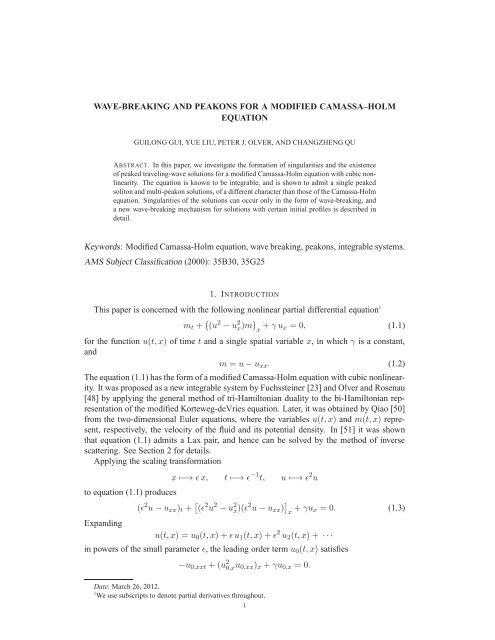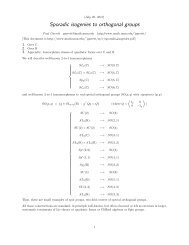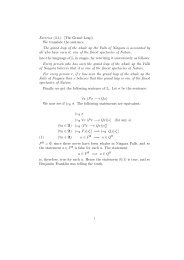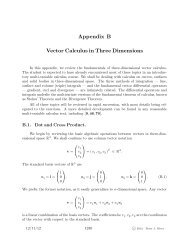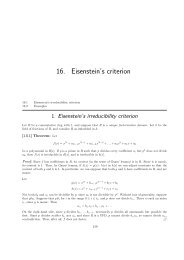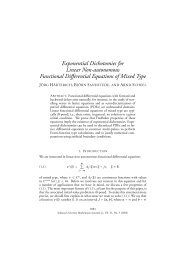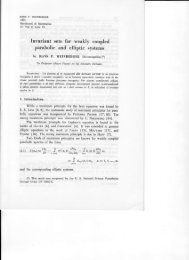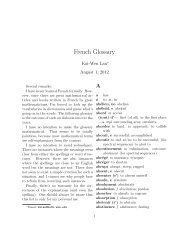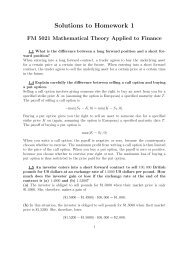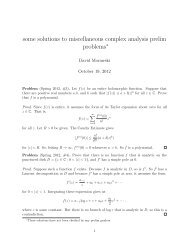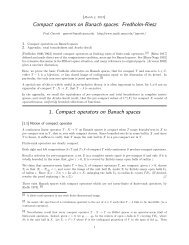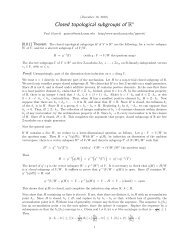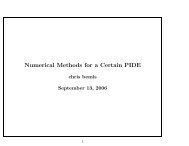WAVE-BREAKING AND PEAKONS FOR A MODIFIED CAMASSA ...
WAVE-BREAKING AND PEAKONS FOR A MODIFIED CAMASSA ...
WAVE-BREAKING AND PEAKONS FOR A MODIFIED CAMASSA ...
Create successful ePaper yourself
Turn your PDF publications into a flip-book with our unique Google optimized e-Paper software.
<strong>WAVE</strong>-<strong>BREAKING</strong> <strong>AND</strong> <strong>PEAKONS</strong> <strong>FOR</strong> A <strong>MODIFIED</strong> <strong>CAMASSA</strong>–HOLM<br />
EQUATION<br />
GUILONG GUI, YUE LIU, PETER J. OLVER, <strong>AND</strong> CHANGZHENG QU<br />
ABSTRACT. In this paper, we investigate the formation of singularities and the existence<br />
of peaked traveling-wave solutions for a modified Camassa-Holm equation with cubic nonlinearity.<br />
The equation is known to be integrable, and is shown to admit a single peaked<br />
soliton and multi-peakon solutions, of a different character than those of the Camassa-Holm<br />
equation. Singularities of the solutions can occur only in the form of wave-breaking, and<br />
a new wave-breaking mechanism for solutions with certain initial profiles is described in<br />
detail.<br />
Keywords: Modified Camassa-Holm equation, wave breaking, peakons, integrable systems.<br />
AMS Subject Classification (2000): 35B30, 35G25<br />
1. INTRODUCTION<br />
This paper is concerned with the following nonlinear partial differential equation 1<br />
mt + (u 2 −u 2 x)m <br />
x +γux = 0, (1.1)<br />
for the function u(t,x) of time t and a single spatial variable x, in which γ is a constant,<br />
and<br />
m = u−uxx. (1.2)<br />
The equation (1.1) has the form of a modified Camassa-Holm equation with cubic nonlinearity.<br />
It was proposed as a new integrable system by Fuchssteiner [23] and Olver and Rosenau<br />
[48] by applying the general method of tri-Hamiltonian duality to the bi-Hamiltonian representation<br />
of the modified Korteweg-deVries equation. Later, it was obtained by Qiao [50]<br />
from the two-dimensional Euler equations, where the variables u(t,x) and m(t,x) represent,<br />
respectively, the velocity of the fluid and its potential density. In [51] it was shown<br />
that equation (1.1) admits a Lax pair, and hence can be solved by the method of inverse<br />
scattering. See Section 2 for details.<br />
Applying the scaling transformation<br />
to equation (1.1) produces<br />
Expanding<br />
x ↦−→ ǫx, t ↦−→ ǫ −1 t, u ↦−→ ǫ 2 u<br />
(ǫ 2 u−uxx)t + (ǫ 2 u 2 −u 2 x)(ǫ 2 u−uxx) <br />
u(t,x) = u0(t,x)+ǫu1(t,x)+ǫ 2 u2(t,x)+ ···<br />
x +γux = 0. (1.3)<br />
in powers of the small parameter ǫ, the leading order term u0(t,x) satisfies<br />
−u0,xxt +(u 2 0,x u0,xx)x +γu0,x = 0.<br />
Date: March 26, 2012.<br />
1 We use subscripts to denote partial derivatives throughout.<br />
1
2 GUILONG GUI, YUE LIU, PETER J. OLVER, <strong>AND</strong> CHANGZHENG QU<br />
We conclude that v = u0,x satisfies the short pulse equation<br />
vxt = 1<br />
3 (v3 )xx +γv. (1.4)<br />
This equation was derived by Schäfer and Wayne [54] as a model for the propagation of<br />
ultra-short light pulses in silica optical fibers, which is also an approximation of nonlinear<br />
wave packets in dispersive media in the limit of few cycles on the ultra-short pulse<br />
scale [9]. Numerical simulations [9] show that the short pulse equation approximation to<br />
Maxwell’s equations in the case when the pulse spectrum is not narrowly localized around<br />
the carrier frequency is better than that obtained from the nonlinear Schrödinger equation.<br />
Well-posedness and wave breaking for the short pulse equation have been studied in [54]<br />
and [43], respectively. It was shown in [5] that the short pulse equation and the WKI equa-<br />
tion [58]<br />
ut =<br />
<br />
uxx<br />
(1+u 2 x) 3<br />
2<br />
x<br />
belong to the same hierarchy. The WKI equation is gauge equivalent to the mKdV equation,<br />
while the short pulse equation is gauge equivalent to the sine-Gordon equation [53]. Solitons<br />
of the mKdV equation and the sine-Gordon equation correspond to loop solitons of the WKI<br />
equation and the short pulse equation, respectively.<br />
The original Camassa-Holm (CH) equation<br />
<br />
mt +umx +2uxm+γux = 0, (1.5)<br />
where m is as above, (1.2), can itself be derived from the Korteweg–deVries equation by<br />
tri-Hamiltonian duality. The Camassa-Holm (CH) equation [6, 24] (see also [17, 36]) was<br />
originally proposed as a model for surface waves, and has been studied extensively in the<br />
last twenty years because of its many remarkable properties: infinity of conservation laws<br />
and complete integrability [6, 19, 24], with action angle variables constructed using inverse<br />
scattering [3, 4, 14, 18], existence of peaked solitons and multi-peakons [1, 6, 7], geometric<br />
formulations [8, 37, 44], well-posedness and breaking waves, meaning solutions that remain<br />
bounded while their slope becomes unbounded in finite time [10, 11, 12, 13, 40]. Note that<br />
the nonlinearity in the CH equation is quadratic. Two integrable CH-type equations with<br />
cubic nonlinearity have been discovered: One is the equation (1.1), and the second is the<br />
Novikov equation [45]<br />
mt +u 2 mx + 3<br />
2 (u2 )xm = 0. (1.6)<br />
The integrability, peaked solitons, well-posedness and blow up phenomena to the Novikov<br />
equation have been studied extensively [34, 35, 45, 56, 57]. An alternative modified CH<br />
equation was introduced in [26]. Multi-component versions of the CH equation have been<br />
introduced and studied in [15, 21, 27, 31, 32, 33, 48].<br />
Dual integrable nonlinear systems, such as the CH and modified CH equations, are endowed<br />
with nonlinear dispersion, which, in most cases, enables them to support non-smooth<br />
soliton-like structures. A number of additional examples of dual integrable systems derived<br />
using the method of tri-Hamiltonian duality can be found in [20, 48]. Dual equations support<br />
a remarkable variety of non-analytic solutions [42], including peakons, compactons,<br />
tipons, rampons, mesaons, and so on. Convergence of analytic solutions to non-analytic<br />
compactons and peakons was proved in [39, 41].<br />
The aim of this paper is to investigate whether the modified CH equation (1.1) has similar<br />
remarkable properties as the CH equation (1.5). Since the modified CH equation has<br />
a cubic nonlinearity which the CH equation is only quadratic, one expects that the modified<br />
CH equation should also have peaked solitons and wave-breaking. The following two<br />
sections review the bi-Hamiltonian structure and geometric formulations of the modified
<strong>WAVE</strong> <strong>BREAKING</strong> <strong>AND</strong> <strong>PEAKONS</strong> <strong>FOR</strong> A <strong>MODIFIED</strong> <strong>CAMASSA</strong>-HOLM EQUATION 3<br />
CH equation. In Section 4, detailed blow-up criteria for strong solutions are established;<br />
see Theorem 4.2. It is shown that the solutions of the modified CH equation can only have<br />
singularities which correspond to wave breaking. A sufficient condition for wave breaking<br />
of strong solutions in finite time is specified in Section 5; see Theorem 5.2. Finally, the<br />
existence of single peakon and multi-peakon solutions is demonstrated in Section 6. Interestingly,<br />
in contrast to the CH equation, withγ = 0, we find that multi-peakon solutions of<br />
(1.1) have only constant amplitudes.<br />
2. GEOMETRIC <strong>FOR</strong>MULATION <strong>AND</strong> INTEGRABILITY<br />
The CH equation (1.5) has the three distinct geometric formulations. First, it describes<br />
the geodesic flows, respectively, on the Bott-Virasoro group for the case γ = 0 [44, 55]<br />
and on the diffeomorphism group of the unit circle under H1 metric for the case γ =<br />
0 [37]. Note that the two geometric descriptions are not analogous: for γ = 0 (on the<br />
diffeomorphism group) the Riemannian exponential map is a local chart, but this is not the<br />
case for γ = 0 (on the Bott-Virasoro group) cf. the discussion in the paper [16]. Second,<br />
it describes families of pseudo-spherical surfaces [26, 52]. Furthermore, it arises from a<br />
non-stretching invariant planar curve flow in the centro-equiaffine geometry [8]. While<br />
it is not clear whether the modified CH equation (1.1) also describes geodesic flows on<br />
diffeomorphism groups, we can show that it arises from an intrinsic (arc-length preserving)<br />
invariant planar curve flow in Euclidean geometry. Indeed, the modified KdV and KdV<br />
equations arise naturally from non-stretching invariant planar curve flows in Euclidean and<br />
centro-equiaffine geometry, respectively [8, 25, 49].<br />
According to the theory of moving frames, [28, 47], any Euclidean-invariant plane curve<br />
flow for C ⊆ R2 has the form<br />
∂C<br />
= f n+gt, (2.1)<br />
∂t<br />
where t and n are the Euclidean tangent and normal vectors, while the normal and tangent<br />
velocities, f andg, are arbitrary Euclidean differential invariants, meaning that they depend<br />
on the curvature and its derivatives with respect to the arc-length s of the curve C. According<br />
to equation (4.13) in [47], which is a consequence of the moving frame calculus<br />
developed for curve and submanifold flows invariant under general Lie group actions, the<br />
curve flow (2.1) is intrinsic or non-stretching, meaning that it preserves arc length, if and<br />
only if<br />
gs −κf = 0. (2.2)<br />
In condition (2.2), the operator producing multiplication by −κ is particular to Euclidean<br />
geometry, and other transformation groups lead to alternative criteria for arc length preservation<br />
of the flow. Furthermore, according to Example 5.5 in [47] (see also [25]) when<br />
the curve evolves intrinsically according to (2.1) with the constraint (2.2), the curvature<br />
invariant satisfies<br />
κt = R[f], where R = ∂ 2 s +κ2 +κs∂ −1<br />
s κ (2.3)<br />
is the well known recursion operator, [46], of the modified KdV equation<br />
κt = κsss + 3<br />
2 κ2 κs, (2.4)<br />
which corresponds to the particular flow (2.1) withf = κs,g = 1<br />
2 κ2 .<br />
Remark 2.1. The operator R is a particular instance, for Euclidean-invariant plane curve<br />
flows, of the general moving frame calculus for invariant submanifold flows that has been<br />
developed in [47]. For example, the evolution of centro-equiaffine curvature under an invariant<br />
curve flow in centro-equiaffine geometry is governed by the KdV recursion operator.<br />
In a similar fashion, the operator governing the evolution of curvature and torsion under the
4 GUILONG GUI, YUE LIU, PETER J. OLVER, <strong>AND</strong> CHANGZHENG QU<br />
Euclidean-invariant flow of a space curve is the recursion operator for vortex filament flow,<br />
which can be mapped to the integrable nonlinear Schrödinger equation under the Hasimoto<br />
transformation, [29, 38]. Many, but not all, Klein geometries produce recursion operators<br />
and integrable systems for the evolution of differential invariants under group-invariant<br />
flow. It remains an intriguing and unresolved mystery as to why integrable systems arise so<br />
often in this geometric context.<br />
In particular, if we set<br />
then by (2.2),<br />
f = −2us, κ = m ≡ u−uss,<br />
g = −(u 2 −u 2 s)+b,<br />
wherebis a constant. Therefore, u(t,s) satisfies the equation<br />
mt + (u 2 −u 2 s)m <br />
s +(b+2)usss −bus = 0. (2.5)<br />
Setting x = s+(b+2)t, (2.5) becomes<br />
mt + (u 2 −u 2 x )m<br />
x +2ux = 0, m = u−uxx, (2.6)<br />
which is equivalent, up to rescaling, to the modified CH equation (1.1). The preceding<br />
derivation implies that the modified CH equation can be regarded as a Euclidean-invariant<br />
version of the CH equation, just as the mKdV equation is a Euclidean-invariant counterpart<br />
to the KdV equation from the viewpoint of curve flows in Klein geometries.<br />
Since it possesses a recursion operator, the modified CH equation (1.1) is formally completely<br />
integrable. Indeed, it can be written in the bi-Hamiltonian form [48, 51]<br />
mt = − (u 2 −u 2 x)m <br />
x −γux = J δH0<br />
δm<br />
= KδH1<br />
δm ,<br />
where<br />
J = −∂xm∂ −1<br />
x m∂x − 1<br />
2 γ∂x and K = ∂ 3 x −∂x<br />
are compatible Hamiltonian operators, while<br />
H0 =<br />
<br />
R<br />
mudx, H1 = 1<br />
4<br />
<br />
R<br />
u 4 +2u 2 u 2 x − 1<br />
3 u4 x +2γu 2 dx. (2.7)<br />
are the corresponding Hamiltonian functionals. According to the Theorem of Magri, [46],<br />
the associated recursion operator R = J ·K −1 produces a hierarchy of commuting Hamiltonian<br />
functionals and bi-Hamiltonian flows — although in this case most are non-local.<br />
The modified CH equation (1.1) also admits the following Lax formulation [51]:<br />
<br />
ψ1 ψ1 ψ1 ψ1<br />
= U(m,λ) , = V(m,u,λ) ,<br />
where<br />
and<br />
ψ2<br />
V(m,u,λ) =<br />
<br />
x<br />
U(m,λ) = 1<br />
2<br />
λ −2 Q+ 1<br />
ψ2<br />
ψ2<br />
<br />
−Q λm<br />
, Q = Q(λ,γ) = 1−<br />
−λm Q<br />
1<br />
2λ2γ, t<br />
2Q(u2 −u2 x) −λ−1 (u−Qux)− 1<br />
2λ(u2 −u2 <br />
x)m<br />
.<br />
λ −1 (u+Qux)+ 1<br />
2 λ(u2 −u 2 x)m −λ −2 Q− 1<br />
2 Q(u2 −u 2 x)<br />
ψ2
<strong>WAVE</strong> <strong>BREAKING</strong> <strong>AND</strong> <strong>PEAKONS</strong> <strong>FOR</strong> A <strong>MODIFIED</strong> <strong>CAMASSA</strong>-HOLM EQUATION 5<br />
3. ANALYTIC PRELIMINARIES<br />
In this paper, we will study the Cauchy problem for the modified Camassa-Holm equation<br />
on the entire line:<br />
⎧<br />
⎪⎨ mt +<br />
⎪⎩<br />
(u 2 −u 2 x)m <br />
x +γux = 0, m = u−uxx t > 0, x ∈ R,<br />
u(0,x) = u0(x), x ∈ R,<br />
(3.1)<br />
u,m −→ 0 as |x| → ∞.<br />
Throughout, various positive constants will be uniformly denoted by a common letter<br />
C. The norm of a Banach space Z is denoted by ·Z. Let S(R) be the space of rapidly<br />
decayingC ∞ functions onR, andS ′ (R) its dual space containing all tempered distributions.<br />
Given T > 0, let C ∞ c ([0,T) ×R) denote the space of all smooth functions with compact<br />
support on [0,T) × R, which may be obtained as the restriction to [0,T) × R of smooth<br />
functions onR 2 with compact support contained in(−T,T)×R.<br />
We will require the notions of strong (or classical) and weak solutions.<br />
Definition 3.1. If m ∈ C([0,T];H s ) ∩ C1 ([0,T];H s−1 ) with s > 1<br />
2 and some T > 0<br />
satisfies (3.1), then m is called a strong solution on [0,T]. If m is a strong solution on<br />
[0,T] for every T > 0, then it is called a global strong solution.<br />
Substituting the formula for m in terms of u into the partial differential equation (3.1)<br />
results in the following fully nonlinear partial differential equation:<br />
ut + u 2 − 1<br />
3 u2 x<br />
Recall that<br />
ux +∂x(1−∂ 2 x) −1 2<br />
3 u3 +uu 2 x +γu + 1<br />
3 (1−∂2 x) −1 u 3 x = 0. (3.2)<br />
u = (1−∂ 2 x) −1 m = p∗m, where p(x) = 1<br />
2 e−|x| , (3.3)<br />
and ∗ denotes the convolution product on R, defined by<br />
<br />
(f ∗g)(x) = f(y)g(x−y)dy.<br />
This formulation allows us to define a weak solution as follows.<br />
R<br />
Definition 3.2. Given initial data u0 ∈ W1,3 (R), the function u ∈ L∞ loc ([0,T),W1,3 loc (R))<br />
is said to be a weak solution to the initial-value problem (3.1) if it satisfies the following<br />
identity:<br />
T<br />
0<br />
<br />
R<br />
<br />
uϕt + 1<br />
3 u3ϕx+ 1<br />
3u3x ϕ+p∗(2 3 u3 +uu 2 x<br />
<br />
+<br />
R<br />
u0(x)ϕ(0,x)dx = 0,<br />
+γu)∂xϕ− 1<br />
3 (p∗u3 x )ϕ dxdt<br />
(3.4)<br />
for any smooth test function ϕ(t,x) ∈ C∞ c ([0,T) × R). If u is a weak solution on [0,T)<br />
for every T > 0, then it is called a global weak solution.<br />
Remark 3.1. Since the Sobolev space W 1,3<br />
loc (R) can be embedded in the Hölder space<br />
Cα (R) with 0 ≤ α ≤ 2<br />
3 , Definition 3.2 precludes the admissibility of discontinuous shock<br />
waves as weak solutions.<br />
Wave breaking relies crucially on strong nonlinear dispersion, which, however, makes<br />
the analysis more challenging. The conservation of the H 1 -norm allows us to control the<br />
solutions to the CH equation. For transport equations, a solution blows up in finite time
6 GUILONG GUI, YUE LIU, PETER J. OLVER, <strong>AND</strong> CHANGZHENG QU<br />
when its slope ux is unbounded from below. To apply this idea, let us rewrite the modified<br />
CH equation (1.1) as a transport equation in terms ofmalong the flow generated byu 2 −u 2 x<br />
mt +(u 2 −u 2 x)mx = −2uxm 2 −γux. (3.5)<br />
Roughly speaking, the transport equation theory ensures that, if the slope<br />
(u 2 −u 2 x )x = 2uxm (3.6)<br />
is bounded, the solution will remain regular, and can’t blow up in finite time. More precisely,<br />
the solution blows up at some finite time T > 0 only if m(t,·)2 L∞ becomes unbounded<br />
on [0,T). From this, together with the Sobolev embedding theorem, one can see that the<br />
solution blows up in finite time if and only if the slope (3.6) is unbounded from below.<br />
Thus to obtain a global solution, the main problem is that it is impossible to be bound<br />
(3.6) in terms of the H1-norm of the solution unless a higher, positive conserved quantity<br />
involved in H3-norm of the solution can be found. To overcome this difficulty, we may<br />
regard the evolution equation (3.5) in terms of the quantity (3.6) being transported along<br />
the flow generated by u2 −u2 x . Then wave breaking can be established by using the global<br />
conservative property of the potential density m along the characteristics; see (5.1) below.<br />
We expect this new method can be found more applications to deal with wave breaking of<br />
the nonlinear dispersive equations with higher nonlinearities.<br />
4. BLOW-UP CRITERIA<br />
In this section, we study the well-posedness and establish criteria for the blow up of<br />
solutions to the Cauchy problem for the modified CH equation (3.1). We first recall some<br />
1-D Moser-type estimates, [27].<br />
Proposition 4.1. For s ≥ 0, the following estimates hold:<br />
fg H s (R) ≤ C f H s (R)g L ∞ (R) +f L ∞ (R)g H s (R)<br />
f∂xg H s (R) ≤ C f H s+1 (R)g L ∞ (R) +f L ∞ (R)∂xg H s (R)<br />
where the C’s are constants independent of f and g.<br />
,<br />
,<br />
(4.1)<br />
The following estimates for solutions to the one-dimensional transport equation have<br />
been used in [2, 27]. The following result is Theorem 3.14 in [2].<br />
Lemma 4.1. Consider the one-dimensional linear transport equation<br />
Let 0 ≤ σ < 1, and suppose that<br />
∂tf +v∂xf = g, f|t=0 = f0. (4.2)<br />
f0 ∈ H σ (R), g ∈ L 1 ([0,T];H σ (R)),<br />
vx ∈ L 1 ([0,T];L ∞ (R)), f ∈ L ∞ ([0,T];H σ (R))∩C([0,T];S ′ (R)).<br />
Thenf ∈ C([0,T];H σ (R)). More precisely, there exists a constant C depending only on σ<br />
such that, for every 0 < t ≤ T ,<br />
and hence,<br />
f(t)Hσ ≤f0Hσ +C<br />
f(t)Hσ ≤eCV(t)f0H<br />
σ +C<br />
t<br />
t<br />
0<br />
0<br />
g(τ)Hσdτ +C<br />
g(τ)Hσdτ <br />
t<br />
0<br />
f(τ)H σV ′ (τ)dτ (4.3)<br />
with V(t) =<br />
t<br />
0<br />
∂xv(τ)L∞ dτ.<br />
In [22], the following local well-posedness result was obtained (with a slight modification).
<strong>WAVE</strong> <strong>BREAKING</strong> <strong>AND</strong> <strong>PEAKONS</strong> <strong>FOR</strong> A <strong>MODIFIED</strong> <strong>CAMASSA</strong>-HOLM EQUATION 7<br />
Theorem 4.1. Let m0 = (1−∂ 2 x )u0 ∈ Hs (R) withs > 1<br />
2 . Then there exists a time T > 0<br />
such that the initial-value problem (3.1) has a unique strong solution m ∈ C([0,T];H s )∩<br />
C1 ([0,T];H s−1 ) and the map m0 ↦→ m is continuous from a neighborhood of m0 in Hs into C([0,T];H s )∩C 1 ([0,T];H s−1 ).<br />
We are now in a position to state a blow-up criterion for the modified CH equation.<br />
Theorem 4.2. Let m0 = (1 − ∂2 x)u0 ∈ Hs (R) be as in Theorem 4.1 with s > 1<br />
2 . Let m<br />
be the corresponding solution to (3.1). Assume T∗ m0 > 0 is the maximum time of existence.<br />
Then<br />
T ∗ m0 < ∞ ⇒<br />
T ∗ m0<br />
0<br />
m(τ) 2 L∞ dτ = ∞. (4.4)<br />
Remark 4.1. The blow-up criterion (4.4) implies that the lifespan T∗ m0 does not depend<br />
on the regularity index s of the initial data m0. Indeed, let m0 be in Hs for some s > 1<br />
2<br />
and consider some s ′ ∈ ( 1<br />
2 , s). Denote by ms (resp., ms ′ ) the corresponding maximal Hs<br />
(resp., Hs′ ) solution given by the above theorem. Denote by T∗ s (resp., T∗ s ′) the lifespan of<br />
ms (resp., ms ′). Since Hs ֒→ Hs′ , uniqueness ensures that T∗ s ≤ T∗ s ′ and that ms ≡ ms ′<br />
on [0,T ∗ s). Now, if T∗ s < T∗ s ′, then we must have ms ′ in C([0,T∗ s];H s′ ). Hence, ms ′ ∈<br />
L 2 ([0,T ∗ s ];L∞ ), which contradicts the above blow-up criterion (4.4). Therefore, T ∗ s = T∗ s ′.<br />
Proof of Theorem 4.2. We shall prove Theorem 4.2 by an inductive argument with respect<br />
to the index s. This can be achieved as follows.<br />
Step 1. For s ∈ ( 1<br />
2 ,1), applying Lemma 4.1 to equation (3.5), thought of as a transport<br />
equation for m, we obtain<br />
m(t)Hs ≤m0H s +C<br />
+C<br />
t<br />
0<br />
t<br />
0<br />
(u 2 −u 2 x)x(τ)L∞m(τ)H s dτ<br />
(uxm 2 )(τ)Hs dτ +C|γ|<br />
t<br />
0<br />
ux(τ)H s dτ<br />
for all 0 < t < T∗ m0 . Owing to the first Moser-type estimate in (4.1), one has<br />
According to (3.3),<br />
uxm 2 H s ≤ C(uxH sm2 L ∞ +uxL ∞m2 H s)<br />
≤ C(uxHsm2 L∞ +uxL ∞mL∞mH s).<br />
(4.5)<br />
(4.6)<br />
ux = ∂x(1−∂ 2 x )−1 m = ∂xp∗m, where ∂xp(x) = − 1<br />
2 sign(x)e−|x| . (4.7)<br />
Young’s inequality implies<br />
uxL∞ ≤ ∂xpL1mL∞ ≤ mL∞, (4.8)<br />
which, together with the fact uxHs ≤ CmHs and (4.6), gives rise to<br />
and<br />
uxm 2 Hs ≤ CmHsm2 L∞ (4.9)<br />
(u 2 −u 2 x )xL∞ = 2muxL∞ ≤ CmL∞uxL∞ ≤ Cm2L ∞. (4.10)<br />
Plugging (4.9) into (4.5) leads to<br />
m(t)Hs ≤ m0Hs +C<br />
t<br />
0<br />
(m(τ) 2 L∞ +|γ|)m(τ)H s dτ, (4.11)
8 GUILONG GUI, YUE LIU, PETER J. OLVER, <strong>AND</strong> CHANGZHENG QU<br />
which, by Gronwall’s inequality, yields<br />
m(t)H s ≤ m0H seC t<br />
0 (m(τ)2 L ∞+|γ|)dτ .<br />
Therefore, if the maximal existence timeT ∗ m0 < ∞ satisfies<br />
the inequality (4.12) implies that<br />
T ∗ m0<br />
0<br />
m(τ) 2 L∞ dτ < ∞,<br />
limsup<br />
t→T∗ m(t)Hs < ∞,<br />
m0 (4.12)<br />
(4.13)<br />
which contradicts the assumption on the maximal existence timeT ⋆ u0 < ∞. This completes<br />
the proof of Theorem 4.2 for s ∈ ( 1<br />
2 ,1).<br />
Step 2. For s ∈ [1,2), by differentiating (3.5) once with respect to x, we have<br />
∂t(mx)+(u 2 −u 2 x)∂x(mx) = −3ux(m 2 )x −2uxxm 2 −γuxx. (4.14)<br />
Applying Lemma 4.1 to (4.14) yields<br />
t<br />
∂xm(t,·)H s−1 ≤ ∂xm0Hs−1 +C (u<br />
0<br />
2 −u 2 x )xL∞∂xmH s−1dτ<br />
t<br />
ux(m 2 )xHs−1 +uxxm 2 <br />
Hs−1 +|γ|uxxH s−1 dτ.<br />
+C<br />
0<br />
Thanks to the Moser-type estimates (4.1) along with (4.8), one deduces<br />
ux∂x(m 2 ) H s−1 ≤ C(uxH sm2 L ∞ +uxL ∞∂x(m 2 ) H s−1)<br />
≤ C(mxHs−1m 2 L∞ +uxL ∞mL∞mH s)<br />
≤ Cm 2 L∞mHs. Using the Moser-type estimates (4.1) again leads to<br />
uxxm 2 H s−1 +|γ|uxx H s−1<br />
≤ C(uxxL ∞m2 H s−1 +uxx H s−1m 2 L ∞ +|γ|uxx H s−1)<br />
≤ C(m 2 L ∞ +|γ|)m H s−1,<br />
where we used the fact that<br />
(4.15)<br />
(4.16)<br />
(4.17)<br />
uxxL∞ ≤ C(mL∞ +p∗mL ∞) ≤ CmL∞ (4.18)<br />
in the last inequality. Using (4.10), (4.16), and (4.17) in (4.15), and combining with (4.11),<br />
we conclude that, for 1 ≤ s < 2, (4.11) holds.<br />
Repeating the same argument as in Step 1, we see that Theorem 4.2 holds for1 ≤ s < 2.<br />
Step 3. Suppose2 ≤ k ∈ N. By induction, we assume that (4.4) holds whenk−1 ≤ s < k,<br />
and prove that it holds for k ≤ s < k +1. To this end, we differentiate (3.5) k times with<br />
respect tox, producing<br />
∂t∂ k xm+(u 2 −u 2 x)∂x(∂ k k−1<br />
xm) = − C ℓ k∂ k−ℓ<br />
x (u 2 −u 2 x)∂ ℓ+1<br />
x m−2∂ k x(uxm 2 )−γ∂ k x∂xu.<br />
ℓ=0
<strong>WAVE</strong> <strong>BREAKING</strong> <strong>AND</strong> <strong>PEAKONS</strong> <strong>FOR</strong> A <strong>MODIFIED</strong> <strong>CAMASSA</strong>-HOLM EQUATION 9<br />
Lemma 4.1 applied to the above again implies that<br />
∂ k xm(t)Hs−k ≤ ∂k xm0 t<br />
Hs−k +C<br />
0<br />
<br />
t<br />
k−1<br />
+C C ℓ k∂k−ℓ x (u 2 −u 2 x)∂ ℓ x∂xm+2∂ k x(uxm 2 )+γ∂ k x∂xu<br />
0<br />
<br />
<br />
<br />
ℓ=0<br />
∂ k xm(τ)H s−km∂xu(τ)L ∞ dτ<br />
<br />
<br />
<br />
(τ) <br />
H s−k<br />
dτ.<br />
(4.19)<br />
Using the first Moser-type estimate in (4.1) and the Sobolev embedding inequality, we have<br />
and <br />
k−1<br />
2∂ k x(uxm 2 )+γ∂ k x∂xu H s−k<br />
<br />
ℓ=0<br />
k−1<br />
≤ C<br />
≤C uxL∞m2H s +uxH sm2 <br />
L∞ +|γ|∂xuH s<br />
≤C uxL∞mL∞mH s +uxH sm2 L∞ +|γ|∂xuH s<br />
≤C m 2 L ∞ +|γ| mH s<br />
<br />
<br />
<br />
x m<br />
C ℓ k ∂k−ℓ<br />
x (u 2 −u 2 x)∂ ℓ+1<br />
ℓ=0<br />
k−1<br />
≤ C<br />
ℓ=0<br />
C ℓ k<br />
C ℓ k<br />
H s−k<br />
<br />
u 2 −u 2 xHs−ℓ+1∂ ℓ ∞ xmL +∂k−ℓ x (u 2 −u 2 x)L∞mH s−k+ℓ+1<br />
<br />
<br />
(uL ∞ +uxL ∞)(u H s−ℓ+1 +ux H s−ℓ+1)m H ℓ+ 1 2 +ε 0<br />
≤ Ckm 2<br />
H k−1 2 +ε mHs, 0<br />
+(u 2<br />
H k−ℓ+1 2 +ε 2<br />
+ux<br />
0 H k−ℓ+1 2 +ε0 )mHs−k+ℓ+1 <br />
where the genius constant ε0 ∈ (0, 1<br />
4<br />
(4.20) and (4.21) into (4.19), we derive from (4.11) (with 1 < s < 1) in Step 1 that<br />
m(t)Hs ≤ m0Hs +C<br />
t<br />
0<br />
<br />
(4.20)<br />
(4.21)<br />
) so that H 1<br />
2 +ε0 (R) ֒→ L ∞ (R) holds. Substituting<br />
2<br />
(m(τ) 2<br />
H k−1 2 +ε +|γ|)m(τ)H s dτ, (4.22)<br />
0<br />
where we used the Sobolev embedding theorem Hk−1 2 +ε0 (R) ֒→ L∞ (R) withk ≥ 2.<br />
Applying Gronwall’s inequality then gives<br />
m(t)Hs ≤ m0Hs exp{C<br />
t<br />
0<br />
(m(τ) 2<br />
H k−1 2 +ε 0<br />
In consequence, if the maximal existence timeT ⋆ u0 < ∞ satisfies<br />
T ⋆ u0<br />
m(τ) 2 L∞ dτ < ∞,<br />
+|γ|)dτ}. (4.23)<br />
0<br />
thanks to the uniqueness of solution in Theorem 4.1, we then find that m(t) k−<br />
H 1 2 +ε0 is<br />
uniformly bounded in t ∈ (0,T ∗ m0 ) by the induction assumption, which along with (4.23)<br />
implies<br />
which leads to a contradiction.<br />
limsup<br />
t→T∗ m(t)Hs < ∞,<br />
m0
10 GUILONG GUI, YUE LIU, PETER J. OLVER, <strong>AND</strong> CHANGZHENG QU<br />
Therefore, Steps 1 to 3 complete the proof of Theorem 4.2. <br />
Remark 4.2. For a strong solution m = u − uxx in Theorem 4.1, the Hamiltonian functionals<br />
(2.7) are conserved, that is<br />
<br />
d<br />
(u<br />
dt R<br />
2 +u 2 <br />
d 4 2 2<br />
x )dx = 0, u +2u ux −<br />
dt R<br />
1<br />
3 u4x +2γu2 dx = 0, (4.24)<br />
for all t ∈ [0,T).<br />
The following blow-up criterion demonstrates that wave-breaking depends only on the<br />
infimum of mux.<br />
Theorem 4.3. Let m0 ∈ Hs (R) be as in Theorem 4.1 with s > 1<br />
2 . Then the corresponding<br />
solution m to (3.1) blows up in finite timeT ∗ m0 > 0 if and only if<br />
lim<br />
t→T∗ inf<br />
m x∈R<br />
0<br />
{(mux)(t, x)} = −∞ (4.25)<br />
Proof. Since, in view of Remark 4.1, the existence time T∗ m0 is independent of the choice<br />
of s, we need only to consider the case s = 3, which relies on a simple density argument.<br />
Multiplying equation (3.5) by m and integrating over R with respect to x, and then integration<br />
by parts, produces<br />
<br />
1 d<br />
m<br />
2dt<br />
R<br />
2 <br />
<br />
2 2<br />
dx = − u −ux mmx dx−2 uxm<br />
R<br />
R<br />
3 <br />
dx−γ uxm dx<br />
R<br />
= 1<br />
<br />
2 2<br />
u −ux 2 x<br />
R<br />
m2 <br />
dx−2 uxm<br />
R<br />
3 dx− γ<br />
<br />
(u<br />
2 R<br />
2 −u 2 x )x dx<br />
<br />
= − (mux)m 2 dx.<br />
We next expand out (4.14):<br />
R<br />
mxt = −2uxxm 2 −6uxmmx −(u 2 −u 2 x )mxx −γuxx<br />
= −2um 2 +2m 3 −6uxmmx −(u 2 −u 2 x )mxx −γuxx.<br />
Multiplying bymx and integrating over R with respect tox, leads to<br />
<br />
1 d<br />
m<br />
2dt<br />
R<br />
2 <br />
x dx =− (u<br />
R<br />
2 −u 2 x )mxmxx<br />
<br />
dx−2 um<br />
R<br />
2 mx dx<br />
<br />
−6 uxmm<br />
R<br />
2 <br />
x dx+2 m<br />
R<br />
3 <br />
mx dx−γ<br />
= 1<br />
<br />
(u<br />
2 R<br />
2 −u 2 x )xm 2 <br />
2<br />
x dx+ uxm<br />
3 R<br />
3 dx<br />
<br />
−6 uxmm<br />
R<br />
2 x dx− γ<br />
<br />
(u<br />
2 R<br />
2 x −u 2 xx)x dx<br />
<br />
=−5<br />
uxxmx dx<br />
R<br />
uxmm<br />
R<br />
2 <br />
2<br />
x dx+ uxm<br />
3 R<br />
3 dx.<br />
Therefore,<br />
<br />
d<br />
(m<br />
dt R<br />
2 +m 2 <br />
x ) dx = −10 (mux)m<br />
R<br />
2 <br />
2<br />
x dx− (mux)m<br />
3 R<br />
2 dx.<br />
Ifmux is bounded from below on[0, T∗ m0 )×R, i.e., there exists a positive constant C1 > 0<br />
such that mux ≥ −C1 on [0, T∗ m0 )×R, then the above estimate implies<br />
<br />
d<br />
(m<br />
dt<br />
2 +m 2 <br />
x ) dx ≤ 10C1 (m 2 +m 2 x ) dx.<br />
R<br />
R
<strong>WAVE</strong> <strong>BREAKING</strong> <strong>AND</strong> <strong>PEAKONS</strong> <strong>FOR</strong> A <strong>MODIFIED</strong> <strong>CAMASSA</strong>-HOLM EQUATION 11<br />
Applying Gronwall’s inequality then yields<br />
m(t) 2 H1 <br />
≤ (m 2 +m 2 x) dx ≤ e 10C1t<br />
m0 2 H1 R<br />
for t ∈ [0, T∗ m0 ), which ensures that the solution m(t,x) does not blow up in finite time.<br />
On the other hand, if<br />
liminf<br />
t↑T<br />
<br />
inf<br />
x∈R (mux(t,x))<br />
<br />
= −∞,<br />
(4.26)<br />
by Theorem 4.1 for the existence of local strong solutions and the Sobolev embedding<br />
theorem, we infer that the solution will blow-up in finite time. The proof of Theorem 4.3 is<br />
then complete. <br />
5. <strong>WAVE</strong>-<strong>BREAKING</strong> MECHANISM IN THE CASE γ = 0<br />
In this section, we derive some sufficient conditions for the breaking of waves for the<br />
initial-value problem (3.1) with the parameter γ = 0, an assumption that, we emphasize,<br />
will hold for the remainder of the paper.<br />
For this purpose, a conservative property of the potential m will be crucial in the proofs<br />
of our blow-up results. Consider the ordinary differential equation<br />
⎧<br />
⎨<br />
⎩<br />
dq(t,x)<br />
dt = (u2 −u 2 x )(t,q(t,x)),<br />
q(0,x) = x,<br />
for the flow generated by u 2 −u 2 x.<br />
x ∈ R, t ∈ [0,T), (5.1)<br />
Lemma 5.1. Let u0 ∈ Hs (R), s > 5<br />
2 , and let T > 0 be the maximal existence time<br />
of the corresponding strong solution u to (3.1). Then (5.1) has a unique solution q ∈<br />
C1 ([0,T)×R,R) such that the mapq(t,·) is an increasing diffeomorphism ofRwith<br />
t <br />
qx(t,x) = exp 2 (mux)(s,q(s,x))ds > 0, for all (t,x) ∈ [0,T)×R. (5.2)<br />
Furthermore,<br />
0<br />
m(t,q(t,x))qx(t,x) = m0(x), for all (t,x) ∈ [0,T)×R. (5.3)<br />
Proof. Since u ∈ C1 [0,T),H s−1 (R) and Hs (R) ֒→ C1 (R), both u(t,x) and ux(t,x)<br />
are bounded, Lipschitz in the space variable x, and of class C1 in time. Therefore, by<br />
well-known classical results in the theory of ordinary differential equations, the initial value<br />
problem (5.1) has a unique solution q(t,x) ∈ C1 ([0,T)×R).<br />
Differentiating (5.1) with respect to x and using (3.6) yields<br />
<br />
d<br />
dtqx = 2(mux)(t,q)qx,<br />
(t,x) ∈ [0,T)×R. (5.4)<br />
qx(0,x) = 1,<br />
The solution to (5.4) is given by<br />
t <br />
qx(t,x) = exp 2 (mux)(s,q(s,x))ds , (t,x) ∈ [0,T)×R. (5.5)<br />
0<br />
For every T ′ < T, it follows from the Sobolev embedding theorem that<br />
sup<br />
(s,x)∈[0,T ′ |(mux)(s,x)| < ∞.<br />
)×R
12 GUILONG GUI, YUE LIU, PETER J. OLVER, <strong>AND</strong> CHANGZHENG QU<br />
We infer from (5.5) that there exists a constant K > 0 such that qx(t,x) ≥ e −Kt , (t,x) ∈<br />
[0,T)×R, which implies that the map q(t,·) is an increasing diffeomorphism of R before<br />
blow-up with<br />
qx(t,x) = exp<br />
<br />
2<br />
t<br />
0<br />
<br />
(mux)(s,q(s,x))ds > 0, for all (t,x) ∈ [0,T)×R.<br />
On the other hand, combining (5.4) with (1.1), we have<br />
∂<br />
∂t [m(t,q(t,x))qx(t,x)] =[mt(t,q)+mx(t,q)qt]qx +mqxt<br />
= qx[mt(t,q)+(u 2 −u 2 x )mx(t,q)]+2uxm 2 qx<br />
= qx[mt +(u 2 −u 2 x)mx +2uxm 2 ] = 0.<br />
Therefore, m(t,q(t,x))qx(t,x) is independent of the time variable t. That is<br />
m(t,q(t,x))qx(t,x) = m(0,x) = u0(x)−u0xx(x).<br />
This completes the proof of Lemma 5.1. <br />
Remark 5.1. Lemma 5.1 shows that, ifm0 = (1−∂ 2 x )u0 does not change sign, thenm(t,x)<br />
will not change sign for any t ∈ [0,T).<br />
Remark 5.2. Since q(t,·): R → R is a diffeomorphism of the line for every t ∈ [0,T), the<br />
L ∞ -norm of any function v(t,·) ∈ L ∞ is preserved under the family of diffeomorphisms<br />
q(t,·), that is,<br />
v(t,·)L∞ = v(t,q(t,·))L ∞, t ∈ [0,T).<br />
Proposition 5.1. Let m0 ∈ H s (R),s ≥ 3 and T > 0 be the maximal time of existence<br />
of the corresponding solution m(t,x) to (3.1) with the initial data m0. Then M := uxm<br />
satisfies<br />
Mt +(u 2 −u 2 x )Mx = −2M 2 −2m(1−∂ 2 x )−1 (u 2 x m)−2m∂x(1−∂ 2 x )−1 (uuxm) (5.6)<br />
for all (t,x) ∈ [0,T)×R.<br />
Proof. From (1.1), we have<br />
(1−∂ 2 x ) ut +(u 2 −u 2 x )ux<br />
<br />
=−(u 2 −u 2 x )mx −2uxm 2 +(1−∂ 2 x ) (u 2 −u 2 x )ux<br />
<br />
=−(u 2 −u 2 x )mx −2uxm 2 +(u 2 −u 2 x )ux −∂ 2 x<br />
(u 2 −u 2 x )ux<br />
=−(u 2 −u 2 x)mx −2uxm 2 +(u 2 −u 2 x)mx −6uxuxxm−2u 2 xmx<br />
=−2uxm 2 −6uxuxxm−2u 2 xmx,<br />
<br />
(5.7)<br />
which implies<br />
ut +(u 2 −u 2 x )ux = −(1−∂ 2 x )−12uxm 2 +6uxuxxm+2u 2 xmx <br />
= −(1−∂ 2 x )−1 (u 2 )xm+2(u 2 xm)x <br />
.<br />
Taking the derivative to (5.8) with respect to x yields<br />
(5.8)<br />
uxt +2u 2 xm+(u2 −u 2 x )uxx = −∂x(1−∂ 2 x )−1 (u 2 )xm+2(u 2 xm)x <br />
. (5.9)<br />
Notice that mt = −(u 2 −u 2 x)mx −2uxm 2 . We deduce from (5.9) that<br />
Clearly,<br />
muxt = −2u 2 xm 2 −(u 2 −u 2 x)uxxm−m∂x(1−∂ 2 x) −1 (u 2 )xm+2(u 2 xm)x<br />
uxmt = −(u 2 −u 2 x )uxmx −2u 2 x m2 .<br />
.
<strong>WAVE</strong> <strong>BREAKING</strong> <strong>AND</strong> <strong>PEAKONS</strong> <strong>FOR</strong> A <strong>MODIFIED</strong> <strong>CAMASSA</strong>-HOLM EQUATION 13<br />
Hence, we obtain the following equation forM = mux:<br />
Mt +(u 2 −u 2 x)Mx = −4M 2 −m∂x(1−∂ 2 x) −1 (u 2 )xm+2(u 2 xm)x<br />
=−4M 2 −m∂x(1−∂ 2 x) −1 (u 2 )xm −2m∂ 2 x(1−∂ 2 x) −1 u 2 xm <br />
=−4M 2 −m∂x(1−∂ 2 x )−1 (u 2 )xm +m(2u 2 x m)−m(1−∂2 x )−1 2u 2 x m<br />
=−2M 2 −2m∂x(1−∂ 2 x )−1 uuxm −2m(1−∂ 2 x )−1 u 2 x m .<br />
<br />
(5.10)<br />
This completes the proof of Proposition 5.1. <br />
Lemma 5.2. Let T > 0 be the maximal time of existence of the solution m(t,x) to the<br />
initial value problem (3.1) with initial data m0 ∈ H s (R) fors ≥ 3. Assumem0 ≥ 0 for all<br />
x ∈ R. Then<br />
|ux(t,x)| ≤ u(t,x), Mt +(u 2 −u 2 x )Mx ≤ −2M 2 +2C1m, (5.11)<br />
for all (t,x) ∈ [0,T)×R, withC1 = 1 √ 2 u0 3 H 1.<br />
Proof. Sincem0(x) ≥ 0 for all x ∈ R, (5.3) and (5.2) imply that<br />
m(t,x) ≥ 0, (5.12)<br />
for all t ∈ [0,T), x ∈ R, and hence<br />
<br />
m(1−∂ 2 x) −1 (u 2 <br />
xm) (t,x) ≥ 0. (5.13)<br />
According to (3.3),<br />
hence<br />
u(t,x) = (p∗m)(t,x) = 1<br />
<br />
e<br />
2 R<br />
−|x−y| m(t,y)dy,<br />
u(t,x) = e−x<br />
2<br />
ux(t,x) = − e−x<br />
2<br />
x<br />
e<br />
−∞<br />
y m(t,y)dy + ex<br />
2<br />
x<br />
−∞<br />
e y m(t,y)dy + ex<br />
2<br />
+∞<br />
e −y m(t,y)dy,<br />
x<br />
+∞<br />
e −y m(t,y)dy,<br />
which, along with (5.12), leads to<br />
u(t,x)+ux(t,x) = e x<br />
+∞<br />
e −y m(t,y)dy ≥ 0,<br />
From this, we have<br />
On the other hand, by (4.7),<br />
u(t,x)−ux(t,x) = e −x<br />
x<br />
x<br />
−∞<br />
x<br />
e y m(t,y)dy ≥ 0.<br />
(5.14)<br />
(5.15)<br />
|ux(t,x)| ≤ u(t,x) for all (t,x) ∈ [0,T)×R. (5.16)<br />
∂x(1−∂ 2 x) −1 (uuxm)(t,x) = ∂xp∗(uuxm)(t,x)<br />
which, together with (5.16), implies<br />
= − 1<br />
2<br />
|∂x(1−∂ 2 x) −1 (uuxm)(t,x)| ≤ 1<br />
2<br />
≤ 1<br />
2 u(t)2 L ∞<br />
+∞<br />
sign(x−y)e −|x−y| (uuxm)(t,y)dy,<br />
−∞<br />
+∞<br />
e −|x−y| (|ux|um)(t,y)dy<br />
−∞<br />
+∞<br />
e −|x−y| m(t,y)dy ≤ u(t) 3 L∞. −∞<br />
(5.17)
14 GUILONG GUI, YUE LIU, PETER J. OLVER, <strong>AND</strong> CHANGZHENG QU<br />
From this, together with the Sobolev inequality u L ∞ (R) ≤ 1<br />
√ 2 u H 1 (R) and (4.24), we<br />
find<br />
|∂x(1−∂ 2 x) −1 (uuxm)(t,x)| ≤<br />
3 1<br />
√2 u(t)H1 = 1<br />
2 √ 2 u0 3 H1 := C1. (5.18)<br />
Therefore, plugging (5.13) and (5.18) in (5.6) leads to the second inequality in (5.11), which<br />
ends the proof of Lemma 5.2. <br />
In view of Theorem 4.3, we find that the solution blows up in finite time if and only<br />
if the slope uxm is unbounded blow. The next theorem shows that if the initial potential<br />
0 ≡ m0(x) is non-negative, then the slope uxm has an uniform upper bound, independent<br />
of the timet, as long as m(t,x) exists.<br />
Theorem 5.1. Let m0 ∈ H s (R),s > 1/2 and T > 0 be the maximal time of existence of<br />
the corresponding solution m(t,x) to (3.1) with the initial data m0. Assume that m0(x) =<br />
(1−∂ 2 x )u0 ≥ 0 for all x ∈ R, and m0(x0) > 0 at some point x0 ∈ R. Then<br />
for all t ∈ [0,T).<br />
sup(m∂xu)(t,x)<br />
≤<br />
x∈R<br />
1<br />
√ u0H1 sup<br />
2 x∈R<br />
m0(x) (5.19)<br />
To prove Theorem 5.1, we need the following lemma due to Constantin and Escher [11].<br />
Lemma 5.3. [11] Let T > 0 and v ∈ C 1 ([0,T);H 2 (R)). Then for every t ∈ [0,T), there<br />
exists at least one point ξ(t) ∈ R with<br />
I(t) := inf<br />
x∈R (vx(t,x)) = vx(t,ξ(t)).<br />
The function I(t) is absolutely continuous on (0,T) with<br />
dI(t)<br />
dt = vtx(t,ξ(t)), a.e. on (0,T).<br />
Proof of Theorem 5.1. As in the proof of Theorem 4.3, we only need to show Theorem 5.1<br />
holds whens = 3. First, Theorem 4.1 implies that M ∈ C([0,T);H s )∩C 1 ([0,T);H s−1 ).<br />
Givent ∈ [0,T), let x0(t) ∈ R be such that<br />
M(t,x0(t)) = sup M(t,x), which implies Mx(t,x0(t)) = 0, a.e. on (0,T). (5.20)<br />
x∈R<br />
Sinces > 1<br />
2 , we have Hs (R) ֒→ C0(R), the space of all continuous functions on R vanishing<br />
as|x| → ∞. Theorem 4.1 implies that<br />
M(t,x0(t)) ≥ 0 for all t ∈ [0,T). (5.21)<br />
Thanks to Lemma 5.1, the mapq(t,·) is an increasing diffeomorphism of R, which implies<br />
that there is y0 = y0(t) ∈ R satisfying<br />
q(t,y0(t)) = x0(t). (5.22)<br />
Hence, in view of Lemma 5.3, it follows from (5.6) and (5.20) that<br />
d<br />
dt M(t,x0(t)) = −2M 2 (t,x0(t))−2 m(1−∂ 2 x) −1 (u 2 xm) (t,x0(t))<br />
which, together with (5.13) and (5.18), leads to<br />
−2 m∂x(1−∂ 2 x) −1 (uuxm) (t,x0(t)), a.e. on (0,T)<br />
(5.23)<br />
d<br />
dt M(t,x0(t)) ≤ −2M 2 (t,x0(t))+2C1m(t,x0(t)), a.e. on (0,T). (5.24)
<strong>WAVE</strong> <strong>BREAKING</strong> <strong>AND</strong> <strong>PEAKONS</strong> <strong>FOR</strong> A <strong>MODIFIED</strong> <strong>CAMASSA</strong>-HOLM EQUATION 15<br />
On the other hand, at the point (t,q(t,y0)) = (t,x0(t)), we have<br />
d<br />
dt m(t,x0(t)) = −2(mM)(t,x0(t)), a.e. on (0,T). (5.25)<br />
It then follows from (5.21) that for all t ∈ [0,T)<br />
m(t,x0(t)) = m0(x0(0))e −2 t<br />
0 M(τ,x0(τ))dτ<br />
≤ m0(x0(0)) ≤ supm0(x),<br />
(5.26)<br />
which along with (5.11), (4.24) and (5.26) implies<br />
x∈R<br />
M(t,x0(t)) = ux(t,x0(t))m(t,x0(t)) ≤ ux(t)L∞m(t,x0(t)) ≤ u(t)L∞m(t,x0(t)) ≤ 1<br />
√ u0H1 supm0(x).<br />
2<br />
x∈R<br />
(5.27)<br />
This completes the proof of Theorem 5.1. <br />
We are now in a position to state the following wave-breaking result.<br />
Theorem 5.2. Suppose m0 ∈ H s (R) with s > 1/2. Let T > 0 be the maximal time of<br />
existence of the corresponding solution m(t,x) to (3.1) with the initial data m0. Assume<br />
m0(x) = (1−∂ 2 x )u0 ≥ 0 for all x ∈ R and m0(x0) > 0 for some x0 ∈ R, and that<br />
T0 ≤ t ∗ := −∂xu0(x0)<br />
√ 2u0 3 H 1<br />
∂xu0(x0) < −<br />
√ 2u0 3 H 1<br />
u0 3 H 1<br />
m0(x0)<br />
1<br />
2<br />
. (5.28)<br />
Then the solution m(t,x) blows up at a time<br />
− 1<br />
<br />
√<br />
2 <br />
2∂xu0(x0) 2<br />
−<br />
2<br />
√ 2<br />
u03 H1 m0(x0)<br />
liminf<br />
t→T −<br />
0<br />
. (5.29)<br />
Moreover whenT0 = t∗ , the following estimate of the blow-up rate holds<br />
<br />
(T0 −t) inf<br />
x∈R M(t,x)<br />
<br />
≤ −1. (5.30)<br />
Proof. Thanks to (5.11) and (5.1), we have<br />
d<br />
dt M(t,q(t,x0)) ≤ −2M 2 (t,q(t,x0))+2C1m(t,q(t,x0)). (5.31)<br />
Similarly, one can see from the equation in (3.1) that<br />
d<br />
dt m(t,q(t,x0)) = −2mM(t,q(t,x0)). (5.32)<br />
DenotingM(t) := 2M(t,q(t,x0)) andm(t) := 2m(t,q(t,x0)), we reformulate (5.31) and<br />
(5.32) as<br />
d<br />
dt M(t) ≤ −M(t)2 +2C1m(t) (5.33)<br />
and<br />
d<br />
m(t) = −m(t)M(t). (5.34)<br />
dt
16 GUILONG GUI, YUE LIU, PETER J. OLVER, <strong>AND</strong> CHANGZHENG QU<br />
Combining this with (5.12), we deduce that<br />
<br />
d 1<br />
dt m(t) 2<br />
d<br />
dt m(t)<br />
<br />
= d<br />
<br />
−<br />
dt<br />
1<br />
m(t) M(t)<br />
<br />
= 1<br />
m(t) 2<br />
<br />
−m(t) d d<br />
M(t)+M(t)<br />
dt dt m(t)<br />
<br />
≥ 1<br />
m(t) 2<br />
<br />
m(t) M(t) 2 −2C1m(t) −m(t)M(t) 2<br />
= −2C1.<br />
Integrating from 0 totleads to<br />
with<br />
(5.35)<br />
1<br />
m(t) 2<br />
d<br />
dt m(t) ≥ C0 −2C1t, (5.36)<br />
C0 := m(0)′<br />
= −M(0) = −(∂xu0)(x0).<br />
m(0) 2 m(0)<br />
Combining this with (5.34) yields<br />
Integrating (5.36) again on [0,t] implies<br />
and hence<br />
<br />
1<br />
≤ C1<br />
m(t)<br />
The quadratic equation<br />
has two roots:<br />
t ∗ := C0<br />
−<br />
2C1<br />
1<br />
2<br />
M(t) = − 1 d<br />
m(t) dt m(t) ≤ −m(t)C0 −2C1t . (5.37)<br />
t 2 − C0<br />
t+<br />
C1<br />
1 1<br />
−<br />
m(t) m(0) ≤ C1t 2 −C0t, (5.38)<br />
<br />
1<br />
= C1<br />
C1m(0)<br />
t 2 − C0<br />
t+<br />
C1<br />
t 2 − C0<br />
t+<br />
C1<br />
1<br />
= 0<br />
2C1m0(x0)<br />
<br />
1<br />
. (5.39)<br />
2C1m0(x0)<br />
<br />
C02<br />
2<br />
−<br />
C1 C1m0(x0) , t∗ := C0<br />
+<br />
2C1<br />
1<br />
<br />
C02<br />
2<br />
−<br />
2 C1 C1m0(x0) ,<br />
Assumption (5.28) implies<br />
2 C0 2<br />
><br />
C1 C1m0(x0) , hence 0 < t∗ < C0<br />
< t∗.<br />
2C1<br />
(5.40)<br />
Thus,<br />
From this, we may find a time 0 < T0 ≤ t ∗ such that<br />
which, by (5.37), implies that<br />
0 ≤ 1<br />
m(t) ≤ C1(t−t ∗ )(t−t∗). (5.41)<br />
m(t) −→ +∞, as t −→ T0 ≤ t ∗ ,<br />
M(t) −→ −∞, as t −→ T0 ≤ t ∗ .<br />
Therefore,<br />
inf<br />
x∈R M(t,x) ≤ M(t) −→ −∞, as t −→ T0 ≤ t ∗ , (5.42)<br />
which, in view of Theorem 4.3, implies that the solution m(t,x) blows up at the time T0.
<strong>WAVE</strong> <strong>BREAKING</strong> <strong>AND</strong> <strong>PEAKONS</strong> <strong>FOR</strong> A <strong>MODIFIED</strong> <strong>CAMASSA</strong>-HOLM EQUATION 17<br />
Having established wave breaking results for (3.1) as above, attention is given to blow-up<br />
rate for the solution. In fact, owing to (5.37) and (5.41), we derive that for all 0 < t < T0<br />
(T0 −t) inf<br />
x∈R M(t,x) ≤ (T0 −t)M(t) ≤ −(T0 −t)m(t)(C0 −2C1t)<br />
1<br />
≤ (T0 −t)<br />
C1(t−t ∗ )(t−t∗) (2C1t−C0)<br />
2(T0 −t)<br />
≤<br />
(t−t ∗ <br />
t−<br />
)(t−t∗)<br />
C0<br />
<br />
,<br />
2C1<br />
(5.43)<br />
which leads to (5.30) when T0 = t ∗ . Therefore, we end the proof of Theorem 5.2. <br />
Remark 5.3. The equation in (3.1) is invariant under the inverse transformation, that is, if<br />
u(t,x) solves (3.1) with initial data u0(x), so does −u(t,x) with initial data −u0(x).<br />
Thanks to Remarks 5.3, 5.1 and the proof of Theorem 5.2, we may readily derive the<br />
following wave-breaking result.<br />
Theorem 5.3. Let m0 ∈ H s (R),s > 1/2 and T > 0 be the maximal time of existence of<br />
the corresponding solution m(t,x) to (3.1) with the initial data m0. Assume that m0(x) =<br />
(1−∂ 2 x)u0 ≤ 0 for all x ∈ R, and m0(x0) < 0 for somex0 ∈ R, and<br />
T0 ≤ t ∗ := ∂xu0(x0)<br />
√ 2u0 3 H 1<br />
∂xu0(x0) ><br />
√ 2u0 3 H 1<br />
−m0(x0)<br />
u0 3 H 1<br />
1<br />
2<br />
. (5.44)<br />
Then the solution m(t,x) blows up at some timeT0 with<br />
− 1<br />
<br />
√<br />
2 <br />
2∂xu0(x0) 2<br />
+<br />
2<br />
√ 2<br />
u03 H1 . (5.45)<br />
m0(x0)<br />
Moreover whenT0 = t∗ , the following estimate of the blow-up rate holds<br />
<br />
(T0 −t) inf<br />
x∈R M(t,x)<br />
<br />
≤ −1. (5.46)<br />
lim inf<br />
t→T −<br />
0<br />
Remark 5.4. It is well known [10] that if the initial datau0 ∈ H 3 (R) andm0 = (1−∂ 2 x )u0<br />
does not change sign, then the corresponding solution to the CH equation exists globally.<br />
While Theorem 5.2 and Remark 5.3 show that, even if the initial potential m0 does not<br />
change sign, equation (3.1) may blow-up in finite time.<br />
6. PEAKED SOLUTIONS IN THE CASE γ = 0<br />
In this section, we discuss the existence of single and multi-peakon solutions to the modified<br />
CH equation (1.1) with γ = 0. Recall first that the single peakon of the CH equation<br />
(1.5) withγ = 0 is given by<br />
Multi-peakon solutions have the form<br />
u(t,x) = ce −|x−ct| , c ∈ R.<br />
u(t,x) =<br />
N<br />
pi(t)e −|x−qi(t)|<br />
, (6.1)<br />
i=1
18 GUILONG GUI, YUE LIU, PETER J. OLVER, <strong>AND</strong> CHANGZHENG QU<br />
wherepi(t) andqi(t),i = 1,2,··· ,N satisfy the following Hamiltonian system of ordinary<br />
differential equations:<br />
q ′ i(t) =<br />
p ′ i (t) =<br />
N<br />
pje −|qi−qj|<br />
, i = 1,2,··· ,N,<br />
j=1<br />
N<br />
pipjsign(qi −qj)e −|qi−qj|<br />
,<br />
j=1<br />
which has the canonical symplectic structure and Hamiltonian function<br />
H = 1<br />
2<br />
(6.2)<br />
N<br />
pi(t)pj(t)e −|qi(t)−qj(t)|<br />
. (6.3)<br />
i,j=1<br />
A rigorous analysis of the Hamiltonian system (6.2) can be found in [30]. It is worth mentioning<br />
that the Novikov equation also admits multi-peakons [34, 35]. The amplitudes of<br />
the multi-peakons of both the CH equation and the Novikov equation depend on time. Interestingly,<br />
as we now show, the amplitudes of multi-peakons for (3.1) with γ = 0 are<br />
independent of time.<br />
Theorem 6.1. For any a = 0, the peaked functions of the form<br />
ua(t,x) = ae −|x−ct| , where c = 2<br />
3 a2 , (6.4)<br />
is a global weak solution to (3.1) withγ = 0, in the sense of Definition 3.2.<br />
Remark 6.1. Note that all peakons (6.4) move with positive wave speed, c > 0. Each<br />
positive wave speed has a peakon and anti-peakon of opposite amplitudes: a = ± 3c/2.<br />
Remark 6.2. At each timet ≥ 0, the peaked solutions ua(t,·) belong to the Lipschitz space<br />
W1,∞ (R). However, we do not know whether general initial data in the space W1,∞ (R)<br />
produces a global weak solution. It’s also not clear whether there is a global weak solution<br />
belonging to the space W 1,3<br />
loc (R) but not in W1,∞ (R), even for special initial data.<br />
Resolving these questions is a goal of our future work.<br />
Proof of Theorem 6.1. We first claim that, for all t ∈ R + ,<br />
∂xua(t,x) = −sign(x−ct)ua(t,x) (6.5)<br />
in the sense of distribution S ′ (R). Clearly (6.5) belongs to L ∞ (R). Moreover, for any test<br />
function ϕ(·) ∈ C∞ c (R), using integration by parts,<br />
<br />
sign(y)e −|y| 0<br />
ϕ(y)dy = − e y +∞<br />
ϕ(y)dy + e −y ϕ(y)dy<br />
R<br />
−∞<br />
0<br />
=−ϕ(0)+ e<br />
−∞<br />
y ϕ ′ (y)dy +ϕ(0)+<br />
0<br />
+∞<br />
which proves the claim.<br />
Let us now set u0,c(x) := ua(0,x) for x ∈ R. Then<br />
As in (6.5), we have<br />
0<br />
e −y ϕ ′ (y)dy =<br />
<br />
e<br />
R<br />
−|y| ϕ ′ (y)dy,<br />
lim<br />
t→0 +ua(t,·)−u0,c(·) W1,∞ = 0. (6.6)<br />
∂tua(t,x) = csign(x−ct)ua(t,x) ∈ L ∞ (R) for all t ≥ 0. (6.7)
<strong>WAVE</strong> <strong>BREAKING</strong> <strong>AND</strong> <strong>PEAKONS</strong> <strong>FOR</strong> A <strong>MODIFIED</strong> <strong>CAMASSA</strong>-HOLM EQUATION 19<br />
Hence, using (6.6), (6.5), (6.7), and integration by parts, we deduce from that, for every test<br />
function ϕ(t,x) ∈ C∞ c ([0,+∞)×R),<br />
+∞<br />
<br />
ua∂tϕ+<br />
0 R<br />
1<br />
3u3a∂xϕ+ 1<br />
3 (∂xua) 3 <br />
ϕ dxdt+ ua(0,x)ϕ(0,x)dx<br />
R<br />
+∞<br />
= − ϕ<br />
0 R<br />
∂tua +u 2 a∂xua − 1<br />
3 (∂xua) 3 dxdt<br />
+∞<br />
<br />
2<br />
= − ϕsign(x−ct)ua c− 3<br />
0 R<br />
u2 (6.8)<br />
<br />
a dxdt.<br />
On the other hand, using (3.3),<br />
+∞<br />
0<br />
R<br />
(1−∂ 2 x ) −1 2<br />
3 u3 a +ua(∂xua) 2 ∂xϕ− 1<br />
3 (1−∂2 x )−1 (∂xua) 3 ϕ dxdt<br />
+∞<br />
= −<br />
We calculate from (6.5) that<br />
0<br />
R<br />
ϕ∂xp∗ ua(∂xua) 2 +ϕp∗ 2u 2 a∂xua + 1<br />
3 (∂xua) 3 dxdt.<br />
2u 2 a∂xua + 1<br />
3 (∂xua) 3 = −2sign(x−ct)u 3 1<br />
a − 3 (sign(x−ct))3 u 3 7<br />
a = 9 ∂x(u 3 a ),<br />
which together with (6.9) leads to<br />
+∞<br />
0<br />
R<br />
2<br />
(1−∂ x) −12 3u3a +ua(∂xua) 2 ∂xϕ− 1<br />
3 (1−∂2 x) −1 (∂xua) 3 ϕ dxdt<br />
T <br />
= − ϕ·∂xp∗<br />
0 R<br />
ua(∂xua) 2 + 7<br />
9 u3 <br />
a dxdt.<br />
Notice from (6.5) that ∂xp(x) = − 1<br />
2 sign(x)e−|x| for x ∈ R, we have<br />
∂xp∗ ua(∂xua) 2 + 7<br />
9 u3a = − 1<br />
2<br />
+∞<br />
−∞<br />
(t,x)<br />
sign(x−y)e −|x−y| 7<br />
9 +sign2 (y −ct) <br />
3c 3c<br />
2 2 e−3|y−ct| dydt.<br />
Whenx > ct, we split the right hand side of (6.11) into the following three parts:<br />
<br />
(t,x)<br />
∂xp∗ ua(∂xua) 2 + 7<br />
9 u3a ct x<br />
= − 3c<br />
<br />
3c<br />
+<br />
4 2 −∞<br />
=: I1 +I2 +I3.<br />
ct<br />
+∞<br />
+<br />
We directly compute I1 as follows:<br />
I1 = − 3c<br />
ct 3c<br />
4 2 −∞<br />
= − 4c<br />
<br />
3c<br />
3 2 e−(x+3ct)<br />
x<br />
(6.9)<br />
(6.10)<br />
(6.11)<br />
<br />
sign(x−y)e −|x−y| 7<br />
9 +sign2 (y −ct) e −3|y−ct| dy<br />
16<br />
9 e−(x−y) e 3(y−ct) dy<br />
ct<br />
−∞<br />
e 4y dy = − c<br />
<br />
3c<br />
3 2 ect−x .<br />
(6.12)<br />
(6.13)
20 GUILONG GUI, YUE LIU, PETER J. OLVER, <strong>AND</strong> CHANGZHENG QU<br />
In a similar manner,<br />
I2 = − 3c<br />
x 3c<br />
4 2 ct<br />
= − 4c<br />
<br />
3c<br />
3 2 e−(x−3ct)<br />
and<br />
I3 = 3c<br />
<br />
3c<br />
4 2<br />
= 4c<br />
3<br />
16<br />
9 e−(x−y) e −3(y−ct) dy<br />
x<br />
ct<br />
+∞<br />
x<br />
3c<br />
2 e(x+3ct)<br />
e −2y dy = − 2c<br />
3<br />
3c<br />
2<br />
16<br />
9 ex−y e −3(y−ct) dy<br />
+∞<br />
x<br />
e −4y dy = c<br />
3<br />
Plugging (6.13)-(6.15) into (6.12), we deduce that for x > ct<br />
∂xp∗ ua(∂xua) 2 + 7<br />
9 u3 <br />
a (t,x) = c<br />
3c<br />
2<br />
<br />
e ct−x −e 3(ct−x)<br />
.<br />
3c<br />
2 e3(ct−x) .<br />
e 3(ct−x) −e ct−x .<br />
(6.14)<br />
(6.15)<br />
(6.16)<br />
While for the case x ≤ ct, we split the right hand side of (6.11) into the following three<br />
parts:<br />
∂xp∗ ua(∂xua) 2 + 7<br />
9 u3 <br />
a (t,x)<br />
= − 3c<br />
x ct +∞<br />
3c<br />
+ + sign(x−y)e<br />
4 2 −∞ x ct<br />
−|x−y| 7<br />
9 +sign2 (y −ct) e −3|y−ct| dy<br />
=: II1 +II2 +II3.<br />
(6.17)<br />
ForII1, a direct computation gives rise to<br />
II1 =− 3c<br />
x 3c<br />
4 2 −∞<br />
=− 4c<br />
<br />
3c<br />
3 2 e−(x+3ct)<br />
Similarly, one obtains<br />
II2 = 3c<br />
ct 3c<br />
4 2 x<br />
= 4c<br />
<br />
3c<br />
3 2 ex−3ct<br />
and<br />
II3 = 3c<br />
<br />
3c<br />
4 2<br />
= 4c<br />
3<br />
16<br />
9 e−(x−y) e 3(y−ct) dy<br />
x<br />
−∞<br />
16<br />
9 ex−y e 3(y−ct) dy<br />
ct<br />
x<br />
+∞<br />
ct<br />
3c<br />
2 e(x+3ct)<br />
e 2y dy = 2c<br />
3<br />
e 4y dy = − c<br />
<br />
3c<br />
3 2 e3(x−ct) .<br />
16<br />
9 ex−y e −3(y−ct) dy<br />
+∞<br />
ct<br />
<br />
3c<br />
x−ct 3(x−ct)<br />
e −e<br />
2<br />
.<br />
e −4y dy = c<br />
3<br />
Plugging (6.18)–(6.20) into (6.7), we deduce that for x ≤ ct<br />
∂xp∗ ua(∂xua) 2 + 7<br />
9 u3 <br />
a (t,x) = −c<br />
3c<br />
2<br />
3c<br />
2 ex−ct .<br />
e 3(x−ct) −e x−ct .<br />
(6.18)<br />
(6.19)<br />
(6.20)<br />
(6.21)
<strong>WAVE</strong> <strong>BREAKING</strong> <strong>AND</strong> <strong>PEAKONS</strong> <strong>FOR</strong> A <strong>MODIFIED</strong> <strong>CAMASSA</strong>-HOLM EQUATION 21<br />
On the other hand, using the definition ofua,<br />
<br />
2 sign(x−ct)ua c− 3u2 ⎧ <br />
⎪⎨<br />
<br />
3c<br />
−c 2 e3(ct−x) −ect−x a (t,x) =<br />
⎪⎩<br />
, for x > ct,<br />
<br />
3c c e3(x−ct) −ex−ct , for x ≤ ct,<br />
2<br />
which along with (6.16) and (6.21) yields<br />
∂xp∗ ua(∂xua) 2 + 7<br />
9 u3 <br />
a (t,x)+sign(x−ct) ua(c− 2<br />
3u2a) (t,x) = 0, (6.22)<br />
for all (t,x) ∈ R + ×R. Therefore, in view of (6.8), (6.11) and (6.22), we conclude that<br />
+∞<br />
0<br />
R<br />
<br />
ua∂tϕ+ 1<br />
3 u3 a∂xϕ+ 1<br />
3 (∂xua) 3 ϕ+(1−∂ 2 x) −1 2<br />
3 u3 a +u(∂xua) 2 ∂xϕ<br />
− 1<br />
3 (1−∂2 x )−1 (∂xua) 3 ϕ<br />
<br />
<br />
dxdt+ ua(0,x)ϕ(0,x)dx = 0<br />
R<br />
for every test functionϕ(t,x) ∈ C∞ c ([0,+∞)×R), which completes the proof of Theorem<br />
6.1. <br />
We now derive the multipeakon solutions of equation (3.1). Assume that equation (3.1)<br />
with γ = 0 has an N-peakon solution of the form (6.1). It follows from Definition 3.2 that<br />
for any ϕ(t,x) ∈ C∞ c ([0,∞)×R), the solution (6.1) satisfies<br />
∞<br />
0<br />
R<br />
<br />
ut +(u 2 − 1<br />
3u2x)ux +(1−∂ 2 x) −1 ∂x( 2<br />
3u3 +uu 2 x)+ 1<br />
3 (1−∂2 x) −1 u 3 x ϕ(x)dxdt = 0,<br />
which is equivalent to the equation<br />
∞<br />
<br />
ut(ψ −ψxx)+ 1<br />
3 (u3ψxxx +u 3 xψxx)−u(u 2 +u 2 x )ψx<br />
<br />
dxdt = 0, (6.23)<br />
0<br />
R<br />
whereϕ = ψ −ψxx,ψ(x) ∈ C∞ c ([0,∞)×R).<br />
A straightforward computation gives<br />
∞<br />
ut(ψ −ψxx)dxdt<br />
I1 =<br />
=<br />
I2 =<br />
0<br />
R<br />
N<br />
∞<br />
j=1<br />
0<br />
+<br />
∞<br />
= 2<br />
0<br />
∞<br />
0<br />
⎛<br />
∞<br />
= ⎝<br />
0<br />
∞<br />
= 2<br />
0<br />
qj(t)<br />
(p<br />
−∞<br />
′ j −pjq ′ j )ex−qj (ψ −ψxx)dxdt<br />
N<br />
∞<br />
∞<br />
(p<br />
j=1<br />
0 qj<br />
′ j +pjq ′ j)e −(x−qj)<br />
(ψ −ψxx)dxdt<br />
N <br />
p ′ jψ(qj)+pjq ′ jψx(qj) <br />
dt,<br />
j=1<br />
<br />
1 3<br />
3 u ψxxx +u<br />
R<br />
3 2 2<br />
xψxx −u(u +ux)ψx dxdt<br />
⎞<br />
q1 N−1 <br />
qj+1 ∞<br />
+ + ⎠<br />
−∞ qj qN j=1<br />
<br />
1 3<br />
3 u ψxxx +u 3 2 2<br />
xψxx −u(u +ux)ψx dxdt<br />
N<br />
j=1<br />
pj<br />
⎛<br />
⎝− 2<br />
3 p3 j −2<br />
N<br />
pjpie −|qi−qj|<br />
<br />
−4<br />
i=1<br />
1≤k
22 GUILONG GUI, YUE LIU, PETER J. OLVER, <strong>AND</strong> CHANGZHENG QU<br />
Substituting the preceding expressions into (6.23), we obtain the following system<br />
p ′ j = 0,<br />
q ′ j<br />
= 2<br />
3 p2 j +2<br />
N<br />
pjpie −|qi−qj|<br />
<br />
+4<br />
i=1<br />
1≤k
<strong>WAVE</strong> <strong>BREAKING</strong> <strong>AND</strong> <strong>PEAKONS</strong> <strong>FOR</strong> A <strong>MODIFIED</strong> <strong>CAMASSA</strong>-HOLM EQUATION 23<br />
1.2<br />
1.0<br />
0.8<br />
0.6<br />
0.4<br />
0.2<br />
u<br />
t = 0 t = 1<br />
6 4 2 2 4 6<br />
FIGURE 1. Single peakon solution of the modified CH equation with<br />
γ = 0, wave speed c = 1, and amplitude a = 3/2.<br />
1.5<br />
1.0<br />
0.5<br />
u<br />
t = 2 t = 3<br />
6 4 2 2 4 6<br />
FIGURE 2. Double peakon solution of the modified CH equation with<br />
γ = 0, wave speeds c1 = 1/2, c2 = 1,<br />
and amplitudes a1 = 3/4, a2 = 3/2.<br />
[6] R. <strong>CAMASSA</strong> <strong>AND</strong> D. D. HOLM, An integrable shallow water equation with peaked solitons,<br />
Phys. Rev. Lett., 71 (1993), 1661–1664.<br />
[7] C. S. CAO, D. D. HOLM, <strong>AND</strong> E. S. TITI, Traveling wave solutions for a class of onedimensional<br />
nonlinear shallow water wave models, J. Dynam. Differential Equations, 16<br />
(2004), 167–178.<br />
[8] K. S. CHOU <strong>AND</strong> C. Z. QU, Integrable equations arising from motions of plane curves I,<br />
Physica D, 162 (2002), 9–33.<br />
[9] Y. CHUNG, C.K.R.T. JONES, T. SCHÄFER, <strong>AND</strong> C.E. WAYNE, Ultra-short pulses in linear<br />
and nonlinear media, Nonlinearity, 18 (2005), 1351 –1374.<br />
[10] A. CONSTANTIN, Existence of permanent and breaking waves for a shallow water equation: a<br />
geometric approach, Ann. Inst. Fourier (Grenoble), 50 (2000), 321–362.<br />
[11] A. CONSTANTIN <strong>AND</strong> J. ESCHER, Wave breaking for nonlinear nonlocal shallow water equations,<br />
Acta Math., 181 (1998), 229–243.<br />
[12] A. CONSTANTIN <strong>AND</strong> J. ESCHER, On the blow-up rate and the blow-up set of breaking waves<br />
for a shallow water equation, Math. Z., 233 (2000), 75–91.<br />
x<br />
x
24 GUILONG GUI, YUE LIU, PETER J. OLVER, <strong>AND</strong> CHANGZHENG QU<br />
[13] A. CONSTANTIN <strong>AND</strong> J. ESCHER, Global existence and blow-up for a shallow water equation,<br />
Ann. Scuola Norm. Sup. Pisa, 26 (1998), 303–328.<br />
[14] A. CONSTANTIN, V. S. GERDJIKOV <strong>AND</strong> R. I. IVANOV, Inverse scattering transform for the<br />
Camassa-Holm equation, Inverse Problems, 22 (2006), 2197–2207<br />
[15] A. CONSTANTIN <strong>AND</strong> R. I. IVANOV, On an integrable two-component Camassa-Holm shallow<br />
water system, Phys. Lett. A, 372 (2008), 7129–7132.<br />
[16] A. CONSTANTIN, T. KAPPELER, B. KOLEV, <strong>AND</strong> P. TOPALOV, On geodesic exponential maps<br />
of the Virasoro group, Ann. Glob. Anal. Geom., 31 (2007), 155–180.<br />
[17] A. CONSTANTIN <strong>AND</strong> D. LANNES, The hydrodynamical relevance of the Camassa-Holm and<br />
Degasperis-Procesi equations, Arch. Ration. Mech. Anal., 192 (2009), 165–186.<br />
[18] A. CONSTANTIN <strong>AND</strong> H. P. MCKEAN, A shallow water equation on the circle, Comm. Pure<br />
Appl. Math., 52 (1999), 949–982.<br />
[19] M. FISHER <strong>AND</strong> J. SCHIFF, The Camassa Holm equation: conserved quantities and the initial<br />
value problem, Phys. Lett. A, 259 (1999), 371–376.<br />
[20] A. S. FOKAS, P. J. OLVER, <strong>AND</strong> P. ROSENAU, A plethora of integrable bi-Hamiltonian equations,<br />
in: Algebraic Aspects of Integrable Systems: In Memory of Irene Dorfman, A.S. Fokas<br />
and I.M. Gel’fand, eds., Progress in Nonlinear Differential Equations, vol. 26, Birkhäuser,<br />
Boston, 1996, pp. 93–101.<br />
[21] Y. FU, Y. LIU, <strong>AND</strong> C. Z. QU, Well-posedness and blow-up solution for a modified twocomponent<br />
periodic Camassa-Holm system with peakons, Math. Ann., 348 (2010), 415–448.<br />
[22] Y. FU, G. GUI, Y. LIU, <strong>AND</strong> C. Z. QU, On the Cauchy problem for the integrable Camassa-<br />
Holm type equation with cubic nonlinearity, Preprint, 2011.<br />
[23] B. FUCHSSTEINER, Some tricks from the symmetry-toolbox for nonlinear equations: generalizations<br />
of the Camassa–Holm equation, Physica D, 95 (1996), 229–243.<br />
[24] B. FUCHSSTEINER <strong>AND</strong> A. S. FOKAS, Symplectic structures, their Bäcklund transformations<br />
and hereditary symmetries, Physica D, 4 (1981/1982), 47–66.<br />
[25] R. E. GOLDSTEIN <strong>AND</strong> D. M. PETRICH, The Korteweg-de Vries hierarchy as dynamics of<br />
closed curves in the plane, Phys. Rev. Lett., 67 (1991), 3203–3206.<br />
[26] P. GÓRKA <strong>AND</strong> E. G. REYES, The modified Camassa–Holm equation, Int. Math. Res. Notes,<br />
2011 (2011), 2617–2649.<br />
[27] G. GUI <strong>AND</strong> Y. LIU, On the global existence and wave-breaking criteria for the two-component<br />
Camassa-Holm system, J. Funct. Anal., 258 (2010), 4251–4278.<br />
[28] H. W. GUGGENHEIMER, Differential Geometry, McGraw–Hill, New York, 1963.<br />
[29] H. HASIMOTO, A soliton on a vortex filament, J. Fluid Mech., 51 (1972), 477–485.<br />
[30] H. HOLDEN <strong>AND</strong> X. RAYNAUD, A convergent numerical scheme for the Camassa-Holm equation<br />
based on multipeakons, Discrete Contin. Dyn. Syst. A., 14 (2006), 505–523.<br />
[31] D. D. HOLM <strong>AND</strong> R. I. IVANOV, Multi-component generalizations of the CH equation: geometrical<br />
aspects, peakons and numerical examples, J. Phys. A, 43 (2010), 492001.<br />
[32] D. D. HOLM <strong>AND</strong> R. I. IVANOV, Two-component CH system: inverse scattering, peakons and<br />
geometry, Inverse Problems, 27 (2011), 045013.<br />
[33] D. D. HOLM, L. Ó NÁRAIGH, C. TRONCI, Singular solutions of a modified two-component<br />
Camassa-Holm equation, Physical Review E, 79 (2009), 016601.<br />
[34] A. N. HONE, H. LUNDMARK, <strong>AND</strong> J. SZMIGIELSKI, Explicit multipeakon solutions of<br />
Novikov’s cubically nonlinear integrable Camassa-Holm type equation, Dyn. Partial Diff. Eq.,<br />
6 (2009), 253–289.<br />
[35] A. N. HONE <strong>AND</strong> J. P. WANG, Integrable peakon equations with cubic nonlinearity, J. Phys.<br />
A, 41 (2008), 372002<br />
[36] R. S. JOHNSON, Camassa-Holm, Korteweg-de Vries and related models for water waves, J.<br />
Fluid Mech., 455 (2002), 63–82.<br />
[37] S. KOURANBAEVA, The Camassa-Holm equation as a geodesic flow on the diffeomorphism<br />
group, J. Math. Phys., 40 (1999), 857–868.<br />
[38] J. LANGER <strong>AND</strong> R. PERLINE, Poisson geometry of the filament equation, J. Nonlin. Sci., 1<br />
(1991), 71–93.<br />
[39] Y. A. LI <strong>AND</strong> P. J. OLVER, Convergence of solitary-wave solutions in a perturbed bi-<br />
Hamiltonian dynamical system. I. Compactons and peakons, Discrete Cont. Dyn. Syst., 4<br />
(1998), 419–432.<br />
[40] Y. A. LI <strong>AND</strong> P. J. OLVER, Well-posedness and blow-up solutions for an integrable nonlinearly<br />
dispersive model wave equation, J. Diff. Eq., 162 (2000), 27–63.
<strong>WAVE</strong> <strong>BREAKING</strong> <strong>AND</strong> <strong>PEAKONS</strong> <strong>FOR</strong> A <strong>MODIFIED</strong> <strong>CAMASSA</strong>-HOLM EQUATION 25<br />
[41] Y. A. LI <strong>AND</strong> P. J. OLVER, Convergence of solitary-wave solutions in a perturbed bi-<br />
Hamiltonian dynamical system. II. Complex analytic behavior and convergence to non-analytic<br />
solutions, Discrete Cont. Dyn. Syst., 4 (1998), 159–191.<br />
[42] Y. A. LI, P. J. OLVER, <strong>AND</strong> P. ROSENAU, Non-analytic solutions of nonlinear wave models,<br />
in: Nonlinear Theory of Generalized Functions, M. Grosser, G. Hörmann, M. Kunzinger, and<br />
M. Oberguggenberger, eds., Research Notes in Mathematics, vol. 401, Chapman and Hall/CRC,<br />
New York, 1999, pp. 129–145.<br />
[43] Y. LIU, D. PELINOVSKY, <strong>AND</strong> A. SAKOVICH, Wave breaking in the short-pulse equation,<br />
Dynamics of PDE, 6 (2009), 291–310.<br />
[44] G. MISIOLEK, A shallow water equation as a geodesic flow on the Bott–Virasoro group, J.<br />
Geom. Phys., 24 (1998), 203–208.<br />
[45] V. NOVIKOV, Generalizations of the Camassa–Holm equation, J. Phys. A, 42 (2009), 342002.<br />
[46] P. J. OLVER, Applications of Lie Groups to Differential Equations, Second Edition, Graduate<br />
Texts in Mathematics, vol. 107, Springer–Verlag, New York, 1993.<br />
[47] P. J. OLVER, Invariant submanifold flows, J. Phys. A, 41 (2008) 344017.<br />
[48] P. J. OLVER <strong>AND</strong> P. ROSENAU, Tri-Hamiltonian duality between solitons and solitary-wave<br />
solutions having compact support, Phys. Rev. E, 53 (1996), 1900–1906.<br />
[49] U. PINKALL, Hamiltonian flows on the space of star-shaped curves, Results Math., 27 (1995),<br />
328–332.<br />
[50] Z. QIAO, A new integrable equation with cuspons and W/M-shape-peaks solitons, J. Math.<br />
Phys., 47 (2006), 112701.<br />
[51] Z. QIAO <strong>AND</strong> X. Q. LI, An integrable equation with nonsmooth solitons, Theor. Math. Phys.,<br />
267 (2011), 584–589.<br />
[52] E. G. REYES, Geometric integrability of the Camassa–Holm equation, Lett. Math. Phys., 59<br />
(2002), 117–131.<br />
[53] A. SAKOVICH <strong>AND</strong> S. SAKOVICH, Solitary wave solutions of the short pulse equation, J. Phys.<br />
A, 39 (2006), L361–L367.<br />
[54] T. SCHÄFER <strong>AND</strong> C. E. WAYNE, Propagation of ultra-short optical pulses in cubic nonlinear<br />
media, Physica D, 196 (2004), 90–105.<br />
[55] J. SCHIFF, The Camassa–Holm equation: a loop group approach, Physica D, 121 (1998), 24–<br />
43.<br />
[56] F. TI ˇGLAY, The periodic Cauchy problem of the modified Hunter-Saxton equation, J. Evol. Eq.,<br />
5 (2005), 509–527.<br />
[57] F. TI ˇGLAY, The periodic Cauchy problem for Novikov’s equation, Int. Math. Res. Notes, 2011<br />
(2011), 4633–4648.<br />
[58] M. WADATI, K. KONNO, <strong>AND</strong> Y. ICHIKAWA, New integrable nonlinear evolution equations,<br />
J. Phys. Soc. Japan, 47 (1979), 1698–1700.<br />
(Guilong Gui) DEPARTMENT OF MATHEMATICS, JIANGSU UNIVERSITY, ZHENJIANG 212013, P. R.<br />
CHINA, <strong>AND</strong> THE INSTITUTE OF MATHEMATICAL SCIENCES, THE CHINESE UNIVERSITY OF HONG KONG,<br />
SHATIN, N.T., HONG KONG<br />
E-mail address: glgui@amss.ac.cn<br />
(Yue Liu) DEPARTMENT OF MATHEMATICS, UNIVERSITY OF TEXAS, ARLINGTON, TX 76019-0408,<br />
USA<br />
E-mail address: yliu@uta.edu<br />
(Peter J. Olver) SCHOOL OF MATHEMATICS, UNIVERSITY OF MINNESOTA, MINNEAPOLIS, MN 55455,<br />
USA<br />
E-mail address: olver@math.umn.edu<br />
(Changzheng Qu) DEPARTMENT OF MATHEMATICS, NINGBO UNIVERSITY, NINGBO 315211, P.R. CHINA<br />
E-mail address: quchangzheng@nbu.edu.cn


